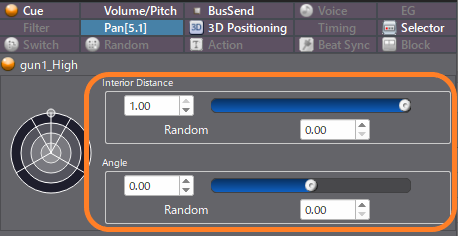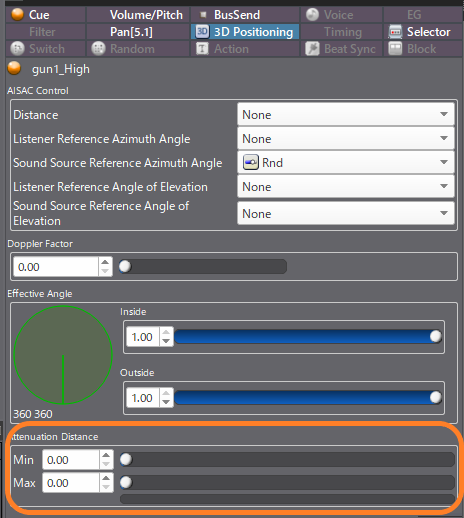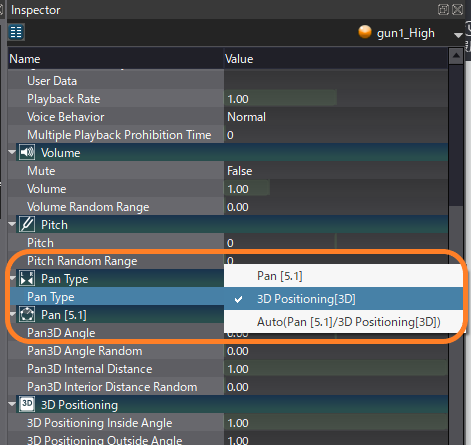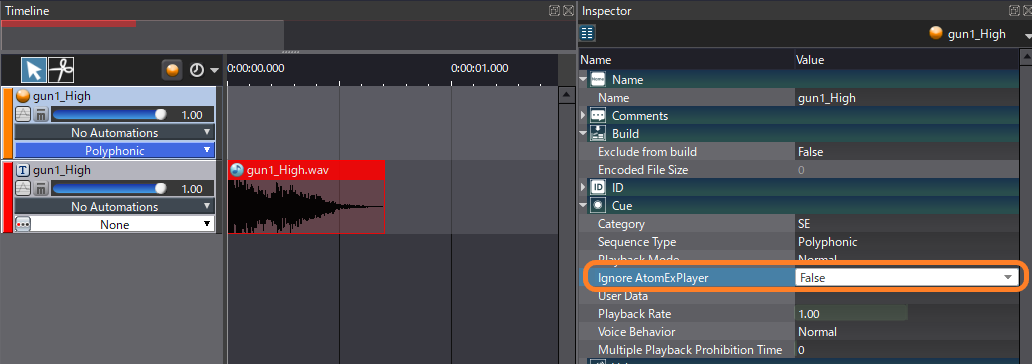There are several types of 3D sounds. Here, we simply refer to the "positioning of the sound image including depth."

In ADX, the traditional panning with a L / R balance is called Pan2D. With it, it is possible to position the sound source between the L and R speakers. 2D pan is used to easily control the sound from the program. L and R levels are specified. There is no settings to be adjusted by the sound designer.
Pan 2D + Depth = Pan
Pan is used to position the sound using L, R, Ls, and Rs levels. Because it is not intuitive to specify a 3D position by setting the output levels of 4 speakers, in ADX, it is expressed as an angle and an interior distance.

This allows for a more intuitive specification of the position of the sound between the 4 speakers.
Pan3D is upward compatible with Pan2D and allows intuitive sound positioning.
The angle between -30 and 30 corresponds to the range -1 to 1 in Pan2D.
Multichannel Material
By default, stereo playback from L and R is possible for 2ch material. For 5.1ch material, 5.1ch surround playback is possible.
3D Positioning
3D positioning is a method to specify the position of a sound based on a different idea from the pan described above. We place a sound source and a listener in a virtual 3D space and the levels for each speaker are calculated based on their position.
At the minimum, 3D positioning requires to set a distance attenuation. Without this setting it, the sound is played back only when the position is the same as the listener (since the sound attenuates with a null distance).

In addition, you must select 3D positioning in the Waveform region settings. You can use this setting to change the sound that is influenced by 3D positioning.

About Monaural Materials
Monaural materials are played back from the specified angle.
Since they are affected by the equi-distance panning, with the initial condition of angle 0, they are played back from L and R with a volume 3dB lower.
When the sound is panned to the position of -30 degrees, it is played back from the L speaker with a volume of 0dB.
About Multichannel Materials
For stereo, the sound has a width of 60-degree.
It is intended to be played back correctly from the speaker position with the initial condition of 0-degree.
For multi-channel materials, Ls and Rs sounds are played back at positions which form an angle of 120-degree.
About Multichannel 7.1ch Materials
In Pan and 3D positioning, the sound is heard from various angles by calculating the position of the sound and distributing it to speakers.
When handling 7.1ch materials, settings are required when initializing the runtime.
For 7.1ch materials, the sound is only sent to each channel when the pan speaker type (output speaker type when calculating the panning) is 6 or 7.
The sound is not correctly sent when the pan speaker type is 4 or 5, since the number of channels decreases.
Angle information is not important since typically the 7.1ch materials are not rotated. When the angle is changed, the sounds of channels are played from the positions relative to these: 30, 110, 150, -30, -110, and -150.
Ignoring 3D Position or 3D Sound Behavior
Normally, it is not recommended to pan materials with more than 2 channels since the sound is mixed between speakers, resulting in incorrect localization.
You can make a Cue that is not affected by panning by setting Ignore AtomExPlayer to True in the Cue Inspector.

This feature has a strong effect and all the player parameters (including the change of volume and AISAC) are ignored.
However, using REACT and categories is possible.
3D Position of 3D Sounds with Special Structure
ADX can handle up to 8ch material for special purpose. The program can specify the position at which each channel is played using the criAtomExPlayer_SetTrackInfo function.
Using this function, the material can be controlled as a Waveform with multiple Tracks (multi-channel sound Track).
In this case, 3D positioning is not available.
Spreading of Multichannel Material
You can change the spreading of multi-channel sound using the criAtomExPlayer_SetPanSpread function.
However, it may create inappropriate changes depending on the sound source since the left and right sounds are mixed.
Multichannel Send Levels
Using the criAtomExPlayer_SetSendLevel function, you can specify from which speaker and with what volume the sound of each channel in the sound data is played.
It is used to create a behavior similar to the common balanced panning, which changes the panning only by adjusting the levels.